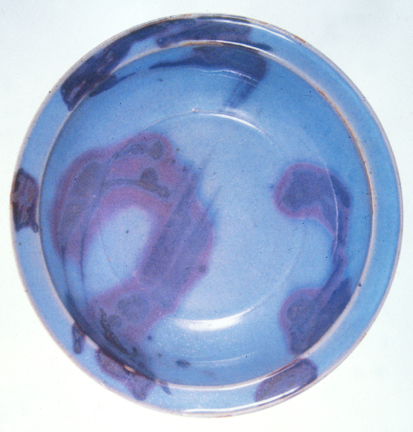
Song Dynasty Plate, Jun Ware, Stoneware
China, 1200 CE
ART 198 - HISTORY OF WORLD CERAMICS
| The plate is another example of Jun (Chun) ware from the Song Dynasty. Again, stoneware clay was used, and here the glaze is turquoise, another of the typical Jun colors. The turquoise color, like the green of the vase in the other Jun example, results from the presence of copper oxide in the glaze. To get the splashes of purple seen here, the potter would first apply the turquoise glaze to the plate, and then using pure copper oxide, would brush a design over the unfired glaze. During the firing process these areas, saturated with copper, would often turn a rich red-violet. As all potters know, copper is the source of many of our most beautiful colors: green, turquoise, reds, violets, for example. Unfortunately, copper is also one of the least dependable, and often yields unexpected results. The plate illustrated on the cover of our text, 10,000 Years of Pottery, by Emmanuel Cooper, is another Song Dynasty Jun plate. Jun ware was made for the wealthy classes, for the temple and for palace use. Many of the flower vases and planters used in the Forbidden City by the emperor and his court were of Jun manufacture. |
Song Dynasty Plate, Jun Ware, Stoneware China, 1200 CE |
|
|